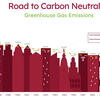Every year on April 22, Earth Day marks the anniversary of the birth of the modern environmental movement in 1970. Earth Day 1970 gave a voice to an emerging public consciousness about the state of our planet. Today, Earth Day is widely recognized as the largest secular observance in the world. Temple University Ambler held its first outdoor, educational program celebrating Earth Day on Apri 22, 2003 and has been hosting programing designed to help students, teachers and families become essential stewards of the Earth as they practice citizen science in the classroom and at home!
How do you celebrate sustainability and the environment while reaching out to students, teachers and residents in a way that will excite them about citizen science and “going green?” In 2003, Dr. Jeffrey Featherstone and a dedicated group of individuals at Temple Ambler presented the answer to that question on a grand scale, developing an outdoor, educational celebration of Earth Day — EarthFest!
Our mission is to provide meaningful, impactful educational experiences for all ages throughout the year. Remember, everyone at every age has the power to effect change. We hope you’ll take a little journey with us through the history of Temple Ambler EarthFest. You may also read more here.
Dr. Jeffrey Featherstone: Leaving The World A Better Place
Director of Temple’s Center for Sustainable Communities. Founding chair of the Department of Planning and Community Development. Professor of Planning and Community Development. Founder of Temple University Ambler EarthFest.
Dr. Jeffrey Featherstone took on many roles at Temple University and he performed them all with seeming ease. His lasting legacy at Temple, the region and well beyond will endure for years to come.
For Featherstone, “sustainability” wasn’t a buzzword. It was an avocation. He welcomed every opportunity to talk about and showcase sustainable concepts to as wide an audience as possible within Temple and within the region. Sustainability is one of the legacies that Featherstone leaves Temple.
We dedicate every moment of every EarthFest event to Dr. Jeffrey Featherstone. Read more about Dr. Featherstone and his lasting impact on the region and the world.
Making a Commitment to Sustainability
April is Earth Month and while Temple University holds special events during the month of April to celebrate, Rebecca Collins, Director of the Temple University Office of Sustainability, wants everyone to know that at Temple, every day is Earth Day. Temple is committed to acting on climate 365 days a year and has pledged carbon neutrality by 2050.
Temple University has made climate action a priority. The University has made great progress driving down emissions. Since 2006, the University has successfully reduced emissions by more than 30 percent. Temple has accomplished this by making sure that our campuses both mimics the natural environment and are energy efficient — we are committed to using natural resources wisely.
Earth Day 2022 - Invest in Our Planet
EarthDay.org, the global organizer of Earth Day, has set the theme for Earth Day - “Invest in Our Planet.” Earth Day (2023 as it was in 2022) is focused on accelerating solutions to combat our greatest threat, climate change, and to activate everyone – governments, citizens, and businesses – to do their part. Everyone accounted for, and everyone accountable.
The Earth Day 2023 theme continues the focus on engaging the more than 1 billion people, governments, institutions, and businesses who participate in Earth Day to recognize our collective responsibility and to help accelerate the transition to an equitable, prosperous green economy for all. The goal of EDO’s campaign is to push aside the barriers erected by the ancient, dirty fossil fuel economy and their co-conspirators – old technologies of centuries past – and redirect attention to creating a 21st century economy that brings back the health of our planet, protects our species, and provides opportunities for all. EarthDay.org’s campaign is focused on reframing the conversation, accelerating action, and bringing us together to understand that this is within our reach if we work together.
Invest In Our Planet. What Will You Do?
For more information on Earth Day 2023, visit: https://www.earthday.org/earth-day-2023/.
What is Earth Day?
Earth Day has been celebrated around the world since 1970 by people from all walks of life who are concerned about preserving the environment. This video from Reading Through History explores the origins of Earth Day and how people all over the globe celebrate Earth Day today,
The History of Earth Day

2020 marked the 50th Anniversary of Earth Day. On April 22, 1970, 20 million Americans took to the streets, parks, and auditoriums to demonstrate for a healthy, sustainable environment in massive coast-to-coast rallies. Temple’s Office of Sustainability and Temple University Libraries’ Special Collections Research Center teamed up to cull the archives for some of the best photos from this special day in April of 1970 and for a conversation about remembering our environmental and social history. The Office of Sustainability spoke with Margery Sly, Director of the Special Collections, to talk about this day and how Earth Day memories from the past help shape a just climate future.
Learn About Earth Day with PBS Kids
April 22 is Earth Day, the perfect time to learn about what we can do to cherish and protect our planet. In this video for young learners, PBS Kids explores what led up to the first Earth Day. Did you know that April 22 was chosen as the date for Earth Day so school children could participate at a time of year that encouraged outdoor activites? Come along and learn more about what communities do to celebrate Earth Day!
It Can Be Done - An Earth Day Message
In summer 2018, the European Space Agency, ESA, joined with the musician Vangelis and the family of scientist Prof. Stephen Hawking to beam a message marking his passing to the nearest black hole. On April 22, 2020, Earth Day, they transmitted this poignant message to all of planet Earth - as a message of hope, to say that, by working together, we can overcome this crisis and others facing humankind. Read the full message here.
Global Earth Challenge - A Citizen Science Intiative
In citizen science, public volunteers contribute to scientific research. Global Earth Challenge™ is helping engage millions of people while integrating billions of data points from new and ongoing citizen science projects. Right now the U.S. Department of State, EarthDay.org and the Wilson Center are trying to understand how insect populations like bees are changing. Collect data on bees today, or support research on air quality, plastics, and food security anytime! Check out the live map of the ongoing bee campaign!
Reporting on Sustainability

Temple's progress towards carbon neutrality has been significant, driving down emissions by 40% since 2006. Our continued investment in systems that support low, and no-carbon operations will allow us to meet out carbon neutrality goal in the future and create a resilient campus even in the face of adversity. Check out the Temple University Sustainability Annual Report. Learn about our continued commitment to sustainability and our progress to the climate action goals we have in place. The Climate Action Plan, released in April 2019, provided a roadmap for continued progress towards carbon neutrality by 2050. Over 300 members of the Temple community collaborated to articulate goals in 5 different focus areas. These are Academics and Research, Culture, Design, Energy, and Operations. The plan reflects a true commitment from Temple students, faculty and staff to work together to shape a more sustainable and just climate future on campus, in Philadelphia and beyond.
Although the COVID-19 outbreak pushed the report’s release, our students, faculty and staff remained committed to climate action. This Sustainability Annual Report details significant progress towards a more environmentally, socially, and economically sustainable future. Visit the Temple Sustainability Blog for more.
Attacking Food Waste and Making Nutrition Accessible

Northern Philadelphia is considered a food desert. You may be wondering what a food desert is and how it contributes to the prevalent issue of food insecurity and scarcity in our neighborhoods. Put simply, food deserts develop as grocery stores cluster around regions with high-paying customers, but are not built in regions of low income households–preventing access to food.
For some context, less than 1 percent of Center City residents live more than a half-mile away from a grocery store. Yet, in North Philly neighborhoods like Belfield or Spring Garden, that number is in the range of 40 to 50 percent, according to a Drexel study. This disparity in the distance makes it difficult for residents in food deserts to have access to healthy and affordable foods. This issue perpetuates an even greater magnitude of resulting problems as these individuals are now more likely to be obese, and suffer from diabetes, heart disease, or malnutrition. Read more. Visit the Temple Sustainability Blog for more.
Microplastics in Philadelphia

America has a plastic problem. We generate over 35 million tons of plastic waste each year, or enough to fill the Dallas Cowboys football stadium every 16 hours. Most of that plastic is sent to landfills or incinerators, both of which are deeply problematic, while the rest of it floats our roads and meanders its way into our waterways.
Philadelphia is no exception. In fact, we’re especially problematic. We consume an estimated 1 billion plastic bags a year while the City’s Water Department removes 44 tons of trash from the Schuylkill and Delaware rivers in a single year. But some forms of plastic are easier to remove than others.
Plastic doesn’t biodegrade like food waste or paper does. It just breaks up into smaller pieces. Those pieces get smaller and small until they are virtually impossible to remove. We call these “microplastics,” or plastics less than 5 millimeters in length. That’s the size of a grain of rice. Visit the Temple Sustainability Blog for more.
What are Microplastics and Gyres?
Plastic waste eventually makes it way from rivers and coastlines to the five churning gyres in our oceans. Over time, larger pieces of plastic are broken down by the sun's ultra-violet light, waves, and salt. This results in tiny pieces being created, which are referred to as microplastics. The video from Plastic Oceans International explores how waterborne chemicals from industry and agriculture stick to microplastics, making them tiny toxic pills - which are easily consumed by marine life, where the toxins are absorbed into tissue ... and eventually make their way into the human food chain.
What Really Happens to the Plastic You Throw Away
We’ve all been told that we should recycle plastic bottles and containers. But what actually happens to the plastic if we just throw it away? In this video from TED-ed, Emma Bryce traces the life cycles of three different plastic bottles, shedding light on the dangers these disposables present to our world.
Foodprints for the Future - Fight Climate Change with Diet Change
A foodprint measures the environmental impacts associated with the growing, producing, transporting, and storing of our food— from the natural resources consumed to the pollution produced to the greenhouse gases emitted. While we should all be working to reduce our foodprints, there are many factors, including access, affordability, health and culture that help shape our decisions about what we eat. There is not one prescribed diet for everyone. Through this campaign, EarthDay.org wants to highlight the different ways individuals and institutions can make an impact on their foodprints.
What is Food Insecurity?
Food insecurity is the reason 925 million people go to bed hungry despite there being enough food to feed the planet. The Thomson Reuters Foundation explains what food insecurity is, and why it is important.
Women in Leadership: Fighting the Climate Crisis Through Climate Literacy
Join EarthDay.org panel of inspirational women from Latin America who have impressive careers in protecting and supporting the environment, youth empowerment and environmental education. The panel will focus on their careers, current initiatives, the state of climate change and climate literacy in Latin America and how we can still make progress in the face of COVID-19.
What's the Big Idea About Climate Change?

Climate has evolved over time. We can see the impacts of the weather change. Explore this great resource by American Museum of Natural History to learn about how the climate has changed and the factors contributing to the change. Featured on the Temple University College of Science and Technology’s LearningScience.org.
Climate Time Machine

NASA’s Climate Time Machine takes students through a series of visualizations that shows how some of Earth’s key climate indicators are changing over time. Students explore Sea Ice, Sea Levels, Carbon Dioxide, and Global Temperatures! Featured on Featured on the Temple University College of Science and Technology’s LearningScience.org.
Humanity's Impact on the Earth
See humanity’s impact on the Earth through a global time-lapse video of the planet since 1984 created by Google and Google Earth. Explore the whole planet here.
Rising Tides: Understanding Sea Level Rise
As human activity warms our planet, the ocean absorbs over 90 percent of the excess heat. This increases water volume and melts ice sheets and glaciers, contributing to sea level rise. This video from NASA Climate Change how much global sea level is rising each year, what that looks like in everyday terms, and why it matters.
NASA Science Live: Rising Seas
Sea levels across the globe are rising as a result of a changing climate — and the rate at which they are rising is accelerating. Watch NASA Science Live to meet NASA researchers studying these changes, and learn how the next mission launching to space will continue the nearly 30-year record of monitoring Earth’s ocean from space.
Youth - The Key to Building a Culture of Preparedness
Sarah Thompson's PrepTalk demonstrates how children are the foundation for building a culture of preparedness and shares how to involve youth in disaster preparedness. Emergency managers tend to think of children only in terms of their vulnerability to a disaster, but there is opportunity to work with children before a disaster strikes. Sarah Thompson is the Director of U.S. Emergencies for Save the Children, where she leads emergency preparedness, recovery and psychosocial programming. She is the author of the Prep Rally curriculum, an innovative program that teaches children preparedness skills through play. Thompson’s PrepTalk focuses on ways to involve youth in improving their disaster preparedness. Video shared with permission from the Federal Emergency Management Agency.
Storytelling to Promote Action
In their PrepTalk, the Federal Emergency Management Agency's The Big One podcast team shares why they developed “The Big One: Your Survival Guide” and how storytelling can help compel people to take action and prepare for disasters. The Big One podcast team works at Southern California Public Radio. The team consists of host Jacob Margolis, producers Arwen Champion Nicks and Misha Euceph, and editor Megan Garvey. The Big One: Your Survival Guide is a nine-episode series released in early 2019 - by April 2019, it had been downloaded more than one million times.

